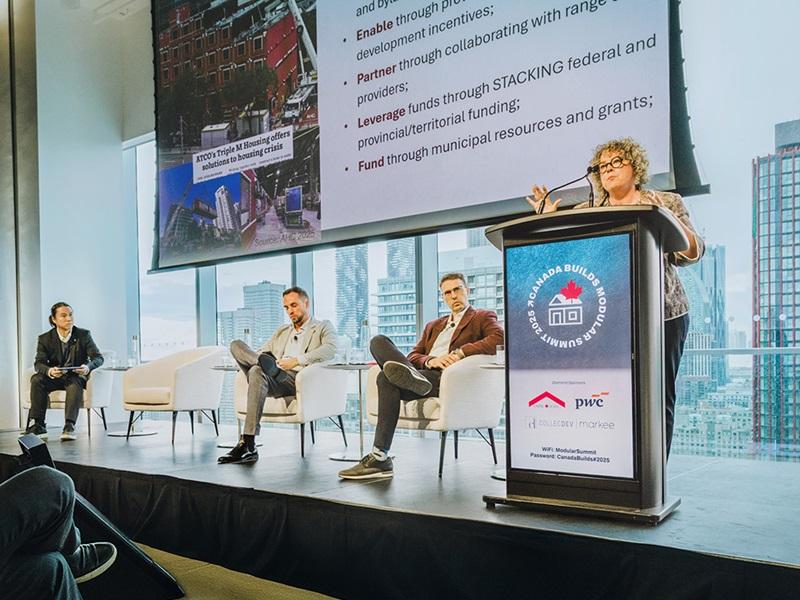
A neighbourhood design that promotes community ownership and enables smaller builders to better compete in the construction market - known as Micro-hoods - has been developed by SvN Architects + Planners.
Fundamental to the idea are small apartment buildings on small lots that are co-owned by the residents within a community land trust. The concept is intended to foster stronger links to the surrounding community, amass the capital to contract smaller developers and to consider innovative construction measures like prefabrication to build faster and more affordably, while reducing environmental impact.
The Micro-hood concept was developed in response to questions which have occupied the Toronto and Vancouver-based firm, Emily Rennalls, an associate senior planner at SvN, told RENX Homes:
- If neighbours co-invested in community development, would it create a greater sense of community?
- If city policies allowed for more neighbourhood businesses, would it lead to more vibrant communities?
“How much more solutions could we generate if more builders had opportunities to participate in urban development?” Rennalls said.
Showcased at Interior Design Show Vancouver 2024, Rennalls said Micro-hoods could be one tool in the kit to tackle some of the biggest challenges facing Canadian cities.
SvN, with offices in Toronto, Vancouver and Mexico City, is an international design firm that has advised on many major projects.
How a Micro-hood works
SvN developed Micro-hoods as its submission to the Urbanarium: Decoding Density Competition. The firm pitched it as a solution to developing more dense Vancouver housing, which would also be more affordable and sustainable, using six-storey-or-higher apartment designs.
Fundamental to the concept is a community land trust, a non-profit owned by the residents which owns and manages the properties under long-term leases. Community resources are pooled to purchase and develop lots with tenure options for affordable housing.
Such a model means long-term affordability is baked in, providing a variety of benefits to residents including seniors being able to age in place under a life-estate mechanism, Rennalls explained.
The theory is if neighbours co-invest, it would mean creating more neighbourhood businesses, thus enriching local vibrancy. More public and green areas would be planted and would be collectively stewarded.
“By challenging policies that prohibit things like neighbourhood-scale shops and services,” Rennalls said, “our hope is that we create those opportunities for serendipitous connections where neighbours can get to know each other and form deeper relationships.”
Supporting smaller developers and newer construction methods
A big challenge in the Metro Vancouver area is the requirement to assemble multiple lots to accommodate larger-scale development, Rennalls explained. Upfront capital investment becomes a barrier to any smaller builders as a result, she continued.
A community land trust would help alleviate the need to amass upfront capital for smaller builders that may not have as many opportunities compared to a larger, private developer.
To construct these Micro-hoods, panelized prefabrication could be employed. By building the parts in a factory, it overcomes a “construction labour crisis” hitting the sector, Rennalls explained.
As knowledge about prefabricated construction is still limited in the industry, Micro-hoods deliver design principles to compensate for the knowledge gap. A SvN document outlines maximum panel lengths for prefabrication as a way of aiding potential users of Micro-hoods.
Prefabrication helps cut construction costs, and thus housing costs, and is associated with improved sustainability outcomes including less waste and fewer greenhouse gas emissions.
SvN does not propose a certain building design for a Micro-hood, but has focused on heights up to six storeys using wood-frame construction, which is cheaper than concrete, Rennalls said.
‘Not a silver bullet’; one of many options
“Ultimately, our aim would be long-term affordability, deeper community ties, and a vibrant neighbourhood where you can walk to meet your daily needs. By making use of or reusing some of the existing buildings within a neighbourhood we can lower our carbon footprint as well,” Rennalls summarized.
The concept is “not a silver bullet” she said, but one of many ideas for addressing the complexities of housing in Canada.
Given an honourable mention at the Urbanarium competition, Rennalls said the recognition shows prefabrication can be a viable construction technique. Some aspect of the Micro-hood idea are already being considered for upcoming SvN projects, she said.










